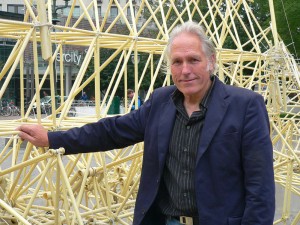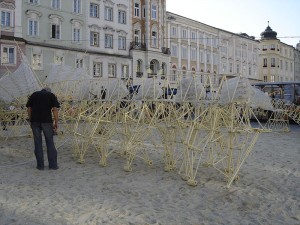The Kinetic Sculptures of Theo Jansen
By Asher Crispe: February 9, 2011: Category Intellivisions, TED talks
 For ages, both science and art have been trying to give us artificial life. Seeking the meaning of life itself, we strive to recreate the creative act through sophisticated simulations. As we mature through trial and error, our simulations may become increasingly fantastic. Often, we begin by copying natural processes. And after careful consideration, we might even uncover a means of stripping those processes down to elementary designs, intuiting that the soul of our creations is equivalent to their abstract form.
For ages, both science and art have been trying to give us artificial life. Seeking the meaning of life itself, we strive to recreate the creative act through sophisticated simulations. As we mature through trial and error, our simulations may become increasingly fantastic. Often, we begin by copying natural processes. And after careful consideration, we might even uncover a means of stripping those processes down to elementary designs, intuiting that the soul of our creations is equivalent to their abstract form.
In the following TED talk we encounter the work of the extraordinary Dutch sculptor and artist, Theo Jansen. He is self-styled as The Great Pretender, following the title of his book that features and explains his work—kinetic sculptures of beach animals that appear to be alive just as he appears to be playing God in acting the part of their creator. There is something both wondrous an unnerving about these simulacra. You have to see them for yourself.

If it moves it must be alive. Or so we once thought. This attempted definition of life persists in many of language. Consider a tag cloud of words such as anima in Latin for the soul, or the Greek anemos connoting the wind, or the Sanskrit aniti which translates as ‘he breathes.’ Furthermore, there are three significant terms for soul in Hebrew: nefesh as breath, ruach as the wind and neshamah which relates to or ‘breath’ once again. There is also the connection between anima and animal, as well as, animation. This has echoes in Hebrew as well in that a fourth term for soul is chayah which can also be understood as ‘life’ or ‘animal’.
Jansen’s animal sculptures embody all of these associations. They are not complete by themselves as static objects but require the wind to move them. Only then do they resemble the living. Add to this the message that the soul cannot reveal itself directly, but only in the motion of otherwise inert bodies, and we can begin to comprehend the significance of being animated by the wind.
Moreover, intentionally or not, Jansen’s creations manage to reproduce many of the classic notions of Divine creativity found throughout the Hebraic Bible. For starters, we find the human condition itself depicted as the quintessential example of kinetic sculpture when God, according to the account in the book of Genesis (2:7), takes earth and shapes it into human form. Adom (Adam) is from the adamah (earth or soil).
More strikingly, we are the sculpture that sculpts. Our capacity to participate in creation and emulate the Creator is evidenced in another play on words within the unvocalized text of the prophet Isaiah (Yesiyahu 14:14): “…I will be like the most High (ehdameh l’elion) .” Minus the vowels—in Hebrew, ehdameh is indistinguishable from the word adamah ‘earth’. Thus, the kabbalists hyperlink these two scriptural contexts and superimpose the meaning of one upon the other. The result is an understanding that the raw material of the earth is molded in such a manner as to create a likeness to its sculptor.
In addition, it should be pointed out that the word adom (Adam) itself shares a sub-root with word damut (resemblance). This resemblance is not physical. Rather, it is an abstract resemblance similar to finding the same mathematical patterns in nature shared amongst diverse objects or different species. In this case, the resemblance revolves around modes of self-expression. Expressions of Divinity (the most High)—like creativity itself—are mirrored in the human condition.
 The explicit labeling of Divine creativity as sculpture can be found in Jeremiah (Yirmeyahu 18:6): “…like matter in the hand of the sculptor.” This metaphor lifts the artistic pursuit of sculpture to the level of metaphysical inquiry. ‘Reality as sculpture’ invites us to consider the fashion in which all of the basic materials of life assume one form and then another through a constant process of remolding. In the idiom of Kabbalah, we are ‘enclothed in a form’ and we ‘strip off that form’ over and over again. Existence is formative. We are continually remodeling.
The explicit labeling of Divine creativity as sculpture can be found in Jeremiah (Yirmeyahu 18:6): “…like matter in the hand of the sculptor.” This metaphor lifts the artistic pursuit of sculpture to the level of metaphysical inquiry. ‘Reality as sculpture’ invites us to consider the fashion in which all of the basic materials of life assume one form and then another through a constant process of remolding. In the idiom of Kabbalah, we are ‘enclothed in a form’ and we ‘strip off that form’ over and over again. Existence is formative. We are continually remodeling.
Returning to Genesis narrative, we might ask what else is conveyed by the clay form of the human? In modern terms, we would call this the plasticity of our physical constitution. Our development ‘shapes’ us. God or Reality or Being sculpts the human being until the point when a higher order emergent phenomenon appears. Life emerges. That God “breathed in to his (Adam’s) nostrils the breath of life,” that Adam became animate and enlivened, only partially compares with the relatively unrefined existence of the animal—the living one who moves and draws breath. Human consciousness generally breaks with that of the animal in that we actively seek to sculpt and be sculpted. To be human is to be trans-human.
The ‘kinetic’ aspect of Jansen’s work imparts a sense of becoming. We are reminded of the process. We are all sculpted. We are moving sculptures and not mere lumps of matter.
Armed with this knowledge, it is no accident that the ideally suited location for displaying Jansen’s work is the beach. Releasing these animals on the beach, beyond the need for wind and a relatively flat and smooth surface in order for them to move, addresses a number of deeper issues. Jansen has established a ‘situational aesthetic’. This means that the context and backdrop for the art on display itself further sculpts the sculpture. The beach scene reverberates in the artistic act in a self-reflective way. The soft sand moistened by the water is the formless bulk of matter awaiting its form. By contrast, the further inland, the drier and harder the earth. The wind dies down. Stillness sets in. All life ceases.
The goal for Jansen is for these animals to ‘feel’ their way back and forth between the boundary conditions that make them what they are. Were they to plunge into the ocean, they would not only break apart, but they would also dissolve their identity. If they wander too far from the water, they would lose the root of what they are as “beach” animals. That thin strip, where the sea kisses the land, is the perfect zone for simulating life.
Beaches are the border spaces between the no-thingness (ayin in Hebrew) of the ocean and the discreet some-thingness (yesh) of the land. This is the narrow margin between discernibly and indiscernibly. We might even suggest that the attraction of beaches originates from an unconscious sense of the weirdness of quantum physics reiterating itself in the everyday world.
More specifically, the beach is the juncture or overlap between the continuous wave and the point-like particles of sand. The notion wave-particle duality or complementarity, is the hallmark of a quantum mechanical description of the construction of the atomic universe. The implication is that the real world springs forth in a manner that can be sculpted just like the wet sand of the beach. For those familiar with Heisenberg’s uncertainty principle—the inherent limits of simultaneous measurement of both position and velocity of sub-atomic particles—the quantum world could be recast in terms of micro-kinetic sculpting.
 In the end, the true goal for Theo Jansen is to allow his creatures to evolve so that they might be able to walk on their own. A Godlike endeavor indeed! He has to strike a balance between involvement as a creator with his inventions, and noninterference—stepping back to permit them a sense of evolving on their own. The parts of failed designs are recycled and reincarnated in the bodies of new animals in a process which mimics the natural world with the bodies of the dead serving as the source of new life. His approach is a heuristic one. Time should bring improvement.
In the end, the true goal for Theo Jansen is to allow his creatures to evolve so that they might be able to walk on their own. A Godlike endeavor indeed! He has to strike a balance between involvement as a creator with his inventions, and noninterference—stepping back to permit them a sense of evolving on their own. The parts of failed designs are recycled and reincarnated in the bodies of new animals in a process which mimics the natural world with the bodies of the dead serving as the source of new life. His approach is a heuristic one. Time should bring improvement.
Ultimately, beyond simply walking, Jansen wants his animals to navigate the pitfalls of these extremes—sand and water, dry and wet, fixed and fluid—autonomously. This will qualify his success. They should be able to dwell on the beach. This is his principle challenge and it just might be one of the greatest challenges in life for the rest of us as well.
The Kinetic Sculptures of Theo Jansen,














;)
;)
;)
;)
;)
;)
;)
;)
;)
;)

Beautifully written, but over the top, no? Comparing something that can mechanically walk to the spirit of man?